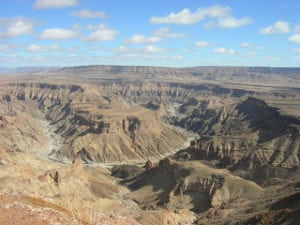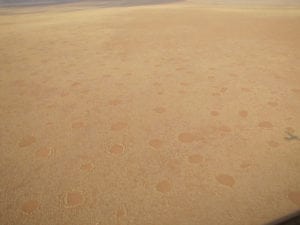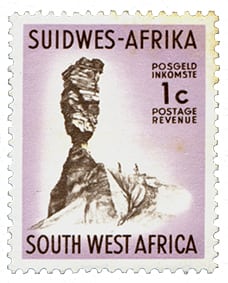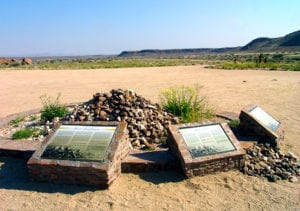The 55-million-year old Namibian Desert is the oldest in the world. It’s no surprise then that it and its surroundings have given rise to ancient lore and legends.
Sometimes legends blur with scientific explanations. Myth or fact? You decide which one to believe.
Namibian Legend 1
Fish River Canyon

Once upon a time a giant snake dwelled in southern Namibia. Every so often it devoured the people’s sheep and goats and so finally they decided to kill the snake. Armed with spears and accompanied by their dogs, the men set out for the hunt. They encircled the snake, keeping it at bay with fiery torches, shooting arrows at it and thrusting spears into its body. Even though it was a giant snake it stood no chance against their superior numbers. In its death throes the snake tossed and turned, tearing deep furrows into the ground.
Or
Geologists tell us that about 500 million years ago, the earth caved in along ancient fissures in its crust, creating a twenty kilometre wide rift valley. Glaciers moving south later deepened the valley and sculpted exposed sediments. Most recently, 50 million years ago the Fish River began to cut its way along the valley floor, meandering between boulders and adding erosion as an influencing force.
See Fish River Canyon on the Victoria Falls to Cape Town and Spectacular South West Africa safaris.
Namibian Legend 2
Fairy Circles

One hundred miles from the closest village, deep in the Namib desert, circular patches devoid of vegetation, dot large areas of ground. They grow for fifty years and then disappear, and Namib grasses reclaim the land.
The Himba people claim they’re footprints left behind by Muruku, their original ancestor, or God.
Tour guides tell stories of the circles being caused by an underground dragon whose poisonous breath destroys the vegetation.
Others have attributed the circles to UFO landings, or the results of fairies linking hands and dancing around and around.
Or
Two natural processes, when combined, have produced the circles in simulations at Princeton University. Sand termites feed off the plant roots and create burrows to act as waterways. Above ground, colonies of plants compete for the same scarce water.
Photo credit: gorbulas_sandybanks on VisualHunt / CC BY-NC-SA
Namibian Legend 3
Mûgorob

A large stone tower once stood in the middle of the desert. It weighted about 450 tons and stood twelve metres high, on a base that was a metre and a half wide, and three metres long.
It vanished on December 8, 1988, leaving only an empty pedestal and a pile of rocks.
Local legend claimed that Mûgorob was a symbol of white supremacy and if Mûgorob collapsed, so would apartheid. The origin of this story is hard to prove. It may have been invented after the rock tumbled, or even after independence in 1990.
Or
There were reports of strong winds in the area but that couldn’t explain the collapse. They may have played a factor, as did the heavy rains pelting the sandstone in the days before the breakdown. Both probably added to the shear forces already at play. The most likely ‘final straw’ was a strong earthquake, 5,000 miles away in Armenia, whose shock waves could be felt in Windhoek.
Namibian Legend 4
Haitsi Aibeb

What looks like piles of stones, usually next to ancient paths, or sometimes waterholes, were called Haitsi Aibeb, after a Nama diety, and held in great respect. Travellers added a sacred gift, like drops of water, venison, or tobacco, then knelt and prayed for safe passage or good hunting.
As a sign of respect, they were not allowed to look back once they left the site. If they did, they risked misfortune.
So if you come across one of these ancient altars on your travels, go ahead and show respect. But don’t look back!
Photo credit Gondwana Collection

